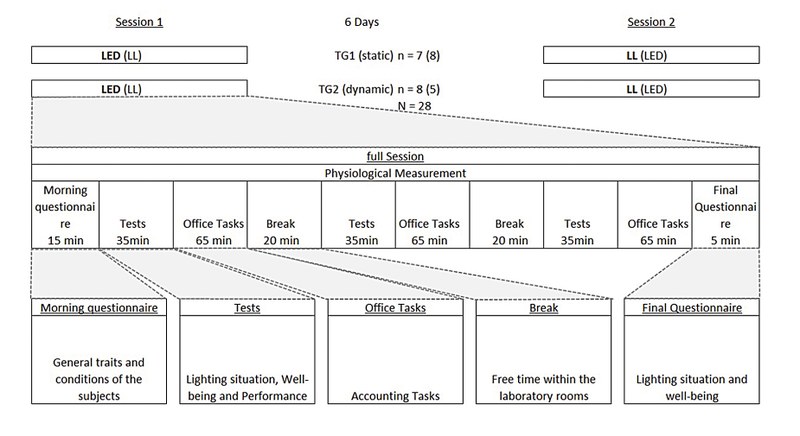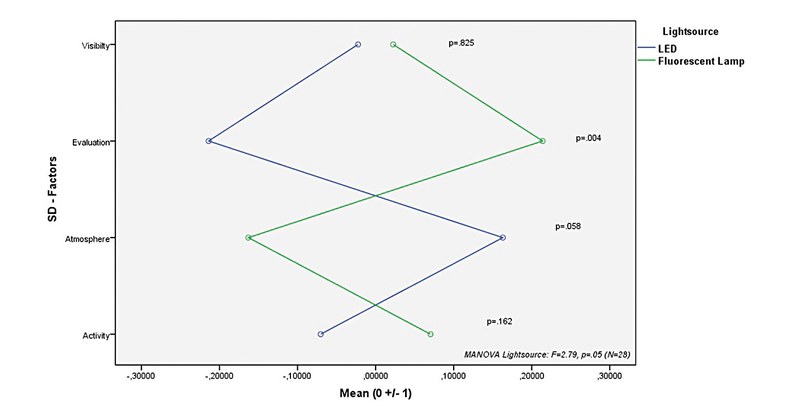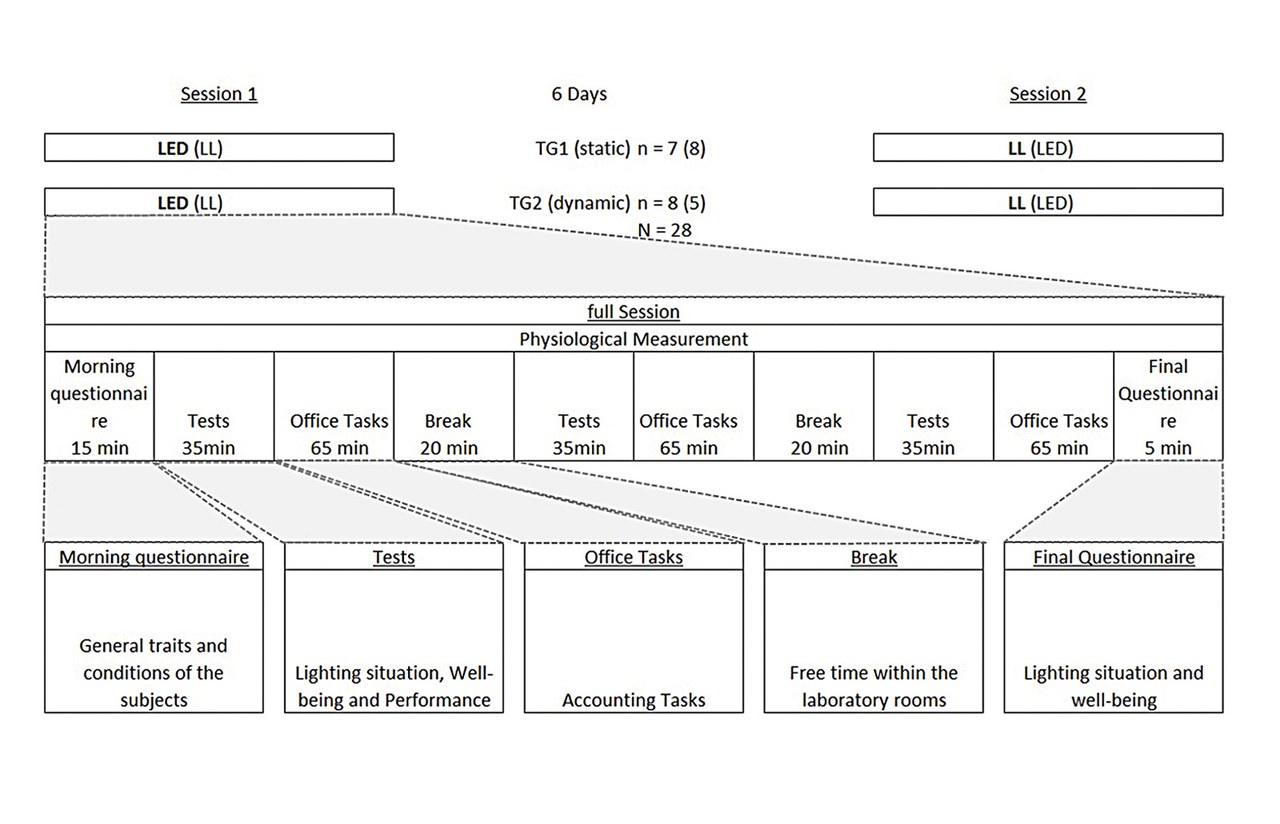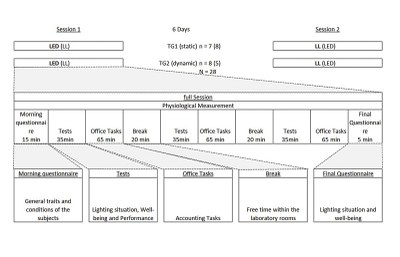LED Office Lighting for Improved Well-Being and Performance
The influence of artificial light in industry has been a topic of conversation for a while now but opportunities provided by LED lighting have made this subject even more important. Katrin Möller, Junior Researcher at the Competence Center Light, her research partners, Vincent Grote from the Human Research Institut, and Birthe Tralau from Zumtobel Lighting, investigated the effects of LED and fluorescent lamp lighting on human well-being and performance in an office environment, in a comparative laboratory study.
The effects of lighting with LED and fluorescent lamps on human well-being and performance have been studied in a In a comparative laboratory study. Two different lighting scenarios (static and dynamic lighting) were implemented and evaluated for both light sources. Twenty-eight subjects between the ages of 20 and 59 years
(16 male, 12 female, 30±11) spent one day for each light source in the laboratory, the lighting scenario being constant. The subjects were tested on their feelings of well-being, concentration and performance as well as having their heart-rate-variability measured.
The results show that LED lighting was rated more interesting, colorful, comfortable, warm, inviting and beautiful than fluorescent lighting (evaluation, p = 0.004) as well as more casual, private and pleasant than fluorescent lighting (p = 0.058). No significant differences were found between LED lighting and fluorescent lighting concerning well-being, performance and concentration. The HRV- parameters shows no significant effects during the test day for the light source and the lighting situation, while the interaction shows significant effects. During the night following the test day significant effects can be seen: The night after fluorescent lighting shows higher heart rates and respiratory rates and variability is significantly lower than during the night after LED lighting.
Introduction
The lighting community has seen two major changes over the past few years. A new light source, the LED, appeared on the scene and an - up until then - unknown third photoreceptor, the intrinsically photoreceptive ganglion cell (ipRGC) was found. The ipRGC has been identified as the link between lighting and many biological functions, especially endocrine and circadian rhythms [1-3].
Since then numerous studies have been undertaken to investigate the link between lighting and its impact on human health and well-being. We now know that blue-enriched light, as well as high levels of illumination and dynamic lighting, enhances alertness and vigilance [4-9]. The activating effects of high color temperature lighting can be improved by planar light sources or indirect lighting using the ceiling or walls [10]. But we also know that one should not increase vigilance and alertness of people ignoring the time of day and the natural rhythm, since this could create several disorders [11].

Figure 1: Study design
With dynamic lighting during the day it is possible to enhance the well-being of people. Increased illuminance levels and high color temperature in the early afternoon, together with a relaxing atmosphere generated through warm white light and low illuminance levels in the evening will help to stabilize the circadian rhythms [12, 13]. This does not only lead to increased performance during the day but also to improved sleep quality at night [14].

Figure 2: Setting and layout
Besides the paradigmatic change in indoor lighting due to increased knowledge about the biological effects, the difference of the spectral light distribution of LED compared to conventional lamps has to be taken into account. The new light source is now not only used in event lighting and media applications. It has started to capture the market of indoor lighting and will soon be used in various applications, e.g. offices, schools and nursing homes.
The above-mentioned studies were performed using conventional light sources, such as fluorescent lamps. LED have different characteristics, the most prominent difference is the continuous light spectrum of LED compared to the spectrum of fluorescent lamps. Therefore it has to be questioned whether the results of former studies on the impact of light on humans can be replicated using LED lighting.
This study investigates the effects of different lighting scenarios (static and dynamic lighting) in a comparison of the innovative light source LED with conventional lighting (fluorescent lamps).
Method
Study design
Twenty-eight subjects ranging in age between 20 and 59 years (16 male, 12 female, 30±11) participated in the laboratory study. The subjects spent one entire workday per lighting situation in the laboratory, with a break of exactly one week between test days. Each test day consisted of office work, specific test phases and breaks. Additionally, heart rate variability was continuously recorded throughout the test days and the following night. (Figure 1)

Figure 3: Dynamic lighting scenario
Setting
In a laboratory setting, two mirrored rooms were set up. The rooms were identical except for the light source used in the luminaires. Figure 2 shows one of the rooms as well as the layout of the laboratory. The size of each office room was 18,5 m2 and consisted of two desks. Therefore two subjects could be tested for each lighting situation. The laboratory rooms were set up without windows to avoid daylight.
Lighting
Four lighting scenarios were investigated within this study: one static (4000 K, 500 lx) and one dynamic scenario (3000 K - 5600 K, 600 lx - 1000 lx; Figure 3) were realized with both light sources LED and fluorescent lamps. The dynamic lighting was designed according to needs due to the human circadian rhythm.
To prevent effects from sources other than the differences in spectra, both types of luminaires were designed to appear identical. Warm white and cold white sources were implemented in both LED and fluorescent lighting. This concept was used for LED’s too, to emulate the same affects of color mixing that occurs for dynamic lighting with fluorescent lamps.
Test material
The subjects spent an entire workday in the laboratory for each light source, two workdays altogether. To avoid biased results due to different weekdays, they were in the laboratory on the same weekday within a time span of two weeks.
The day started with an evaluation of the subjective sleeping quality (HRI-Sleep [15]), the general Well-Being (BSKE [16])and health (SF-12 [17]; MKSL [18]) of the subject. During the day the subjects were tested on concentration (KLT-R [19]), sleepiness (Karolinska Sleepiness Scale [20]) and well- being as well as perception of the lighting situation; three times in total. At the end of the test day the subjects were tested using the MKSL-questionnaire on physical complaints once again and rated their subjective well-being during the day, in general. Heart rate variability was continuously measured for objective data on stress and recovery each day that the subject spent in the laboratory.

Figure 4: Perception of the lighting situation
Results
Psychological tests Perception of lighting situation A factor analysis results in four factors of perception of the lighting situation: visibility, evaluation, atmosphere and activity. LED lighting is perceived as more interesting, colorful, comfortable, warm, inviting and beautiful than fluorescent lighting (evaluation, p = 0.004 - Figure 4). The atmosphere of LED lighting is perceived as more casual, private and pleasant than fluorescent lighting (p = 0.058).
A separate questionnaire confirmed that LED lighting is perceived as more pleasant (p=.003) than fluorescent lighting.
Well-being
No significant differences in well-being could be found for the within-subjects-factor light source (LED or fluorescent lamp) and the between-subjects factor lighting situation (static or dynamic lighting).
Concentration and performance
No significant differences in performance and concentration could be found for the within- subjects-factor light source (LED or fluorescent lamp) and the between- subjects factor lighting situation (static or dynamic lighting). The interaction light source x lighting situation shows lower error ratios for static lighting for LED and fluorescent lighting and higher rates for dynamic lighting especially for LED (Table 1).
Physiological tests
No significant effects have been found in the HRV-parameters concerning the vegetative activation during the test day in the laboratory for the light source (within-subject) and the lighting situation (between- subject). The interaction light source x lighting situation shows significant effects for nearly all HRV-parameters: In contrast to the dynamic lighting, the heart rate is lower for LED lighting than for
fluorescent lighting in the static lighting situation. Considering the psychometric results (comparable well-being and performance - Table 2), the implemented static LED-lighting and the implemented dynamic FL-lighting can be rated better than the static FL-lighting and the dynamic LED-lighting, respectively.
Table 1-3: See in the attachment above
During the nights following the test days, significant effects could be shown for the within-subject-factor light source (LED, fluorescent lamp -Table 3). The night following the testing with fluorescent lamps shows higher heart rates and respiratory rates, respectively during sleep and variability (SDNN, TOT, LF) is significantly lower compared with the night after testing with LED-lighting.
The lighting situation (static vs. dynamic) shows no influence.
Discussion
The results in the vegetative regulation during the laboratory day cannot be distinctly explained by the authors. These effects (interaction between light source and lighting situation) did not originate in the recorded and controlled moderating factors such as general traits of the subjects (e.g. age, gender) or methodical influences of the test procedure.
The sleep parameters of the HRV show that possible nonvisual effects of artificial lighting during the day take effect and appear significantly during the following night’s sleep. The perception and evaluation shows a significantly better rating of LED lighting compared to fluorescent lamps in two factors, while all other factors do not show significant differences.
From these results we conclude that nonvisual effects of lighting need to take into account the effects on sleep and especially long-term and longitudinal studies are needed to answer questions concerning health related questions on the biological importance of artificial lighting in work environments.
Outlook
Currently the authors are conducting a field study in an office environment. Considering the results of the laboratory study, the lighting scenarios consist of only LED lighting. Three lighting situations are investigated: static lighting (4000 K, 500 lx), static lighting with increased illuminance (4000 K, 900 lx) and dynamic lighting as described above. Each lighting scenario is run for four weeks in consecutive order. The subjects are tested once a week on well-being, concentration, performance and perception of the lighting situation. Heart rate variability is measured for physiological data on vegetative activation.
References
[1] Lok, C., Vision science: Seeing without seeing. Nature, 2011. 469(7330): p. 284-5
[2] Berson, D.M., F.A. Dunn, and M. Takao, Phototransduction by retinal ganglion cells that set the circadian clock.Science, 2002. 295(5557): p. 1070-3
[3] Lockley, S.W., Circadian Rhythms and other brain functions, in 2nd CIE Expert Symposium on “Lighting andHealth”. 2006. p. 22-26
[4. Lockley, S.W., et al., Short-wavelength sensitivity for the direct effects of light on alertness, vigilance, and the waking electroencephalogram in humans. Sleep, 2006. 29(2): p. 161-8
[5] Geerdinck, L.M. and L.J. Schlangen, Well-Being Effects of high color temperature lighting in office and industry, in 2nd CIE Expert Symposium on “Lighting and Health”. 2006. p. 126-130
[6]. Knoop, M., A. Tenner, and M. Schriek, Energieeffizienz und erhöhte Akzeptanz von Lichtlösungen mit nichtvisueller Wirkung, in Licht2008. 2008. p. 512-518
[7]. Rea, M.S., et al., Implications for white light sources of different colour temperatures, in 2nd CIE Expert Symposium on “Lighting and Health”. 2006
[8] Rea, M.S., M.G. Figueiro, and J.D. Bullough, Circadian photobiology: an emerging framework for lighting practice and research. Lighting Research Technology, 2002. 34: p. 177-190
[9] Fostervold, K.I. and J. Nersveen, Proportions of direct and indirect indoor lighting - The effect on health, well-being and cognitive performance of office workers. Lighting Research Technology, 2008. 40: p. 175-200
[10]Lang, D. and M. Fassian, Planungsempfehlungen für biologisch effiziente Beleuchtung. Licht und Lebensqualität, 2007.
[11] Boyce, P., Education: the key to the future of lighting practice. Lighting Research Technology, 2006. 38(4): p. 283-294
[12] van Bommel, W., Dynamic Lighting at work - Both in level and colour, in 2nd CIE Expert Symposium on “Lighting and Health”. 2006
[13]Veitch, J., et al., Lighting appraisal, wellbeing and performance in open-plan offices: A linked mechanism approach. Lighting Research Technology, 2008. 40: p. 133-151
[14] Rea, M.S., Light - Much more than vision, in Light and Human Health: EPRI/LRO 5th International Lighting Research Symposium. 2002, The Lighting Research Office of the Electric Power Research Institute: Palo Alto, CA. p. 1-15
[15]Grote, V., Schlaferholung und Herzratenvariabilität als Indikatoren für Wohlbefinden und Gesundheit - Ergebnisse zur aktuellen Schlaferholung im Kontext von Schlafdauer, Schlafdefizit, Beanspruchung, Wohlbefinden und kardial-vegetativen Regulationskennwerten der Herzratenvariabilität bei nicht schlafgestörten Erwachsenen, in Naturwissenschaftliche Fakultät. 2009, Karl-Franzens-Universität: Graz. p. 211
[16]Janke, W. and M. Hüppe, Befindlichkeitsskalierungen durch Kategorien und Eigenschaftswörter: Die BSKE (EWL). 1994, Lehrstuhl für Biologische und Klinische Psychologie
[17]Mc Horney, C.A., J.E. Ware, and A.E. Racek, The MOS 36-item short-form health status survey (SF-36): II. Psychometric and clinical tests of validity in measuring physical and mental health constructs. Medical Care, 1993. 31(247-263)
[18]Erdmann, G. and W. Janke, Mehrdimensionale körperliche Symptomliste aktuell (MKSL-ak). 1994, Psychologisches Institut: Berlin-Würzburg
[19] Düker, H., et al., Konzentrations-Leistungs-Test (KLT-R) [Concentration achievement test - Revised version]. 2001, Göttingen: Hogrefe
[20]Akerstedt, T. and M. Gillberg, Subjective and objective sleepiness in the active individual. Int J Neurosci, 1990. 52(1-2): p. 29-37





